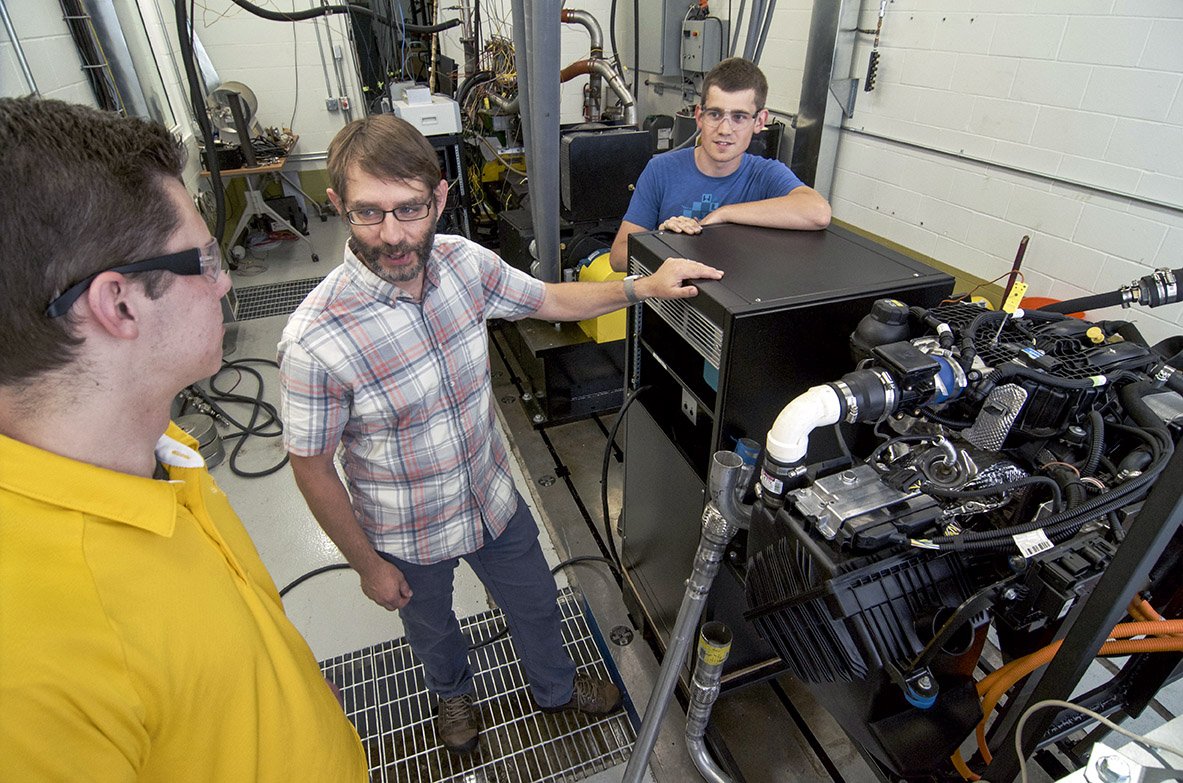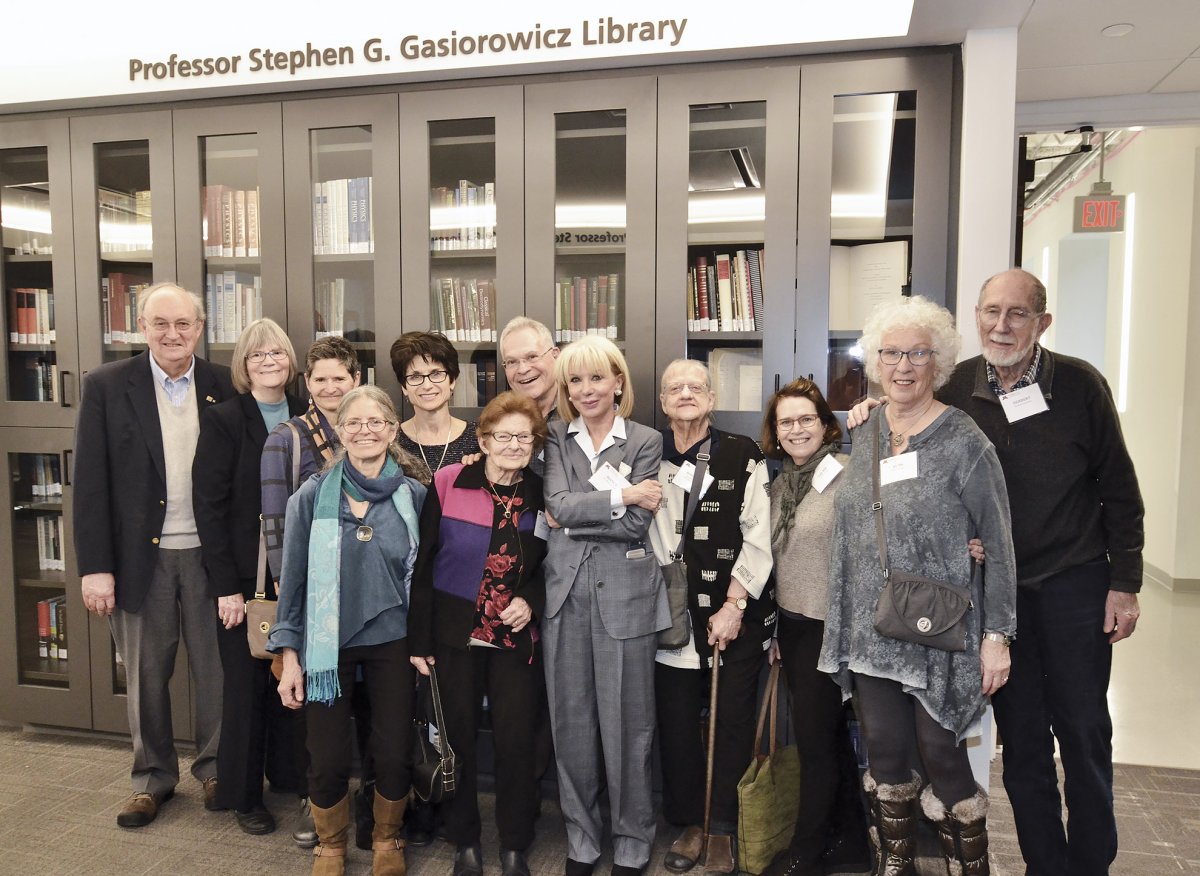You name it: Donors give to teaching and research spaces

Above: The Andersons, pictured here with past CSE dean Steven Crouch (left) and current dean Mos Kaveh.
Alumni leave legacy in CSE spaces
July 25, 2019
Driving vintage sports cars in Brainerd, Minn., is a hobby Clifford Anderson shares with Professor Emeritus Patrick Starr.
It was Starr who introduced Anderson, a 1962 University of Minnesota business graduate who started his collegiate life at CSE (then-called Institute of Technology), to former dean Steven Crouch— who was enthusiastic about Starr’s education philosophy and the University of Minnesota Solar Vehicle Project he advised for 14 years.
In 2008, Anderson made his first significant contribution to the project. In 2018, Anderson honored Starr by dedicating a new campus workspace for the student group in his name. The Patrick J. Starr Solar Vehicle Project Laboratory, which opened last November, is just one of many capital projects in which Anderson and his wife, Nancy, have invested.
Their support of the college, he said, is motivated by wanting to educate “multi-tasking” engineers.
“The U is very famous for research, but it is also a main source of graduating engineers,” Anderson said.
“I’m very much interested in helping the education of engineers beyond the blackboard and lecture,” he explained. “Our economy needs engineers who can work with others and who have broad perspective—engineers who can explain what they’ve built and also why it’s cheaper or more reliable.”
The Andersons are also the people behind three Clifford I. and Nancy C. Anderson Student Innovation Labs on the East Bank. Nearly 600 CSE students use the labs at least once each semester.
The 10,000-square-foot hands-on learning space includes a design lab with 3D printers and laser cutters, a machine shop with state-of-the-art manufacturing equipment, and a third space with a 3D scanner and woodworking equipment.
In addition to the named spaces, the Andersons have generously supported the Lind Hall renovation and updating instructional labs across the college.
“I always asked the dean, ‘what is it you need that you’re not getting from the budgeting process?’” said Anderson.
“If what he tells me fits in with my idea of preparing our future engineers, then all I do is give it a little nudge,” he added.
Dynamometer driven, and more
At the College of Science and Engineering, supporters of experiential learning—like the Andersons— are steadfast and plentiful. Their gifts are often personal, or driven by personal reasons.
“It’s almost an obligation to give back if we received good benefits from a good education,” said Charles Lo (ME ’70, M.S. ’73, MBA ’93).
He and his wife, Maryanne, made the inaugural gift for the Thomas E. Murphy Engine Research Lab, which moved into its renovated space at an industrial park near the Twin Cities campus in 2013.

Their contribution led to two new dynamometers, expanding the University’s ability to study alternative fuels and perform state-of- the-art combustion research.
“When we learned that the lab was still using dynamometers from the late 1940s for its teaching and research activities,” Lo recalled, “Maryanne and I decided to help. We felt that the lab needed modern equipment to educate our students and do advanced studies in order to maintain the U’s national ranking.”
Conversations over tea
It was a former faculty advisor who spurred a gift from William Bardeen (Physics Ph.D. ’68) and his wife, Marjorie (Math ’63).
The Stephen G. Gasiorowicz Collaboration Space, located on the second floor of Tate Hall in the William I. Fine Theoretical Physics Institute, was designed to facilitate dialogue and to house Professor Gasiorowicz’s book collection.
Faculty, students, and post-docs are regular users of the space. In fact, a weekly conversation over tea is held there—a tradition many have said Gasiorowicz would have appreciated.

“Steve was an active, young professor who made it interesting to be at Minnesota,” Bardeen recalled.
“I remember him being very busy, but he had a warm personality and was always helpful,” Bardeen said.
“He also had a very broad knowledge of what was going on in physics around the world. I was inspired and guided by him.”
In addition to being a gifted teacher, Gasiorowicz was instrumental in turning the William I. Fine Theoretical Physics Institute into an internationally renowned physics research center. He died at age 88 in 2016.
“I’m happy to be able to preserve Steve’s name in the place he helped found,” Bardeen said.
Story by Pauline Oo
If you’d like to support student experiences or facilities at the University of Minnesota College of Science and Engineering, visit our CSE Giving website.
